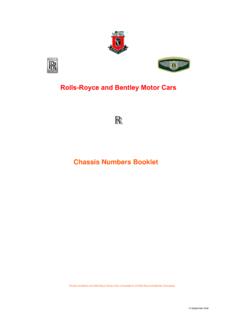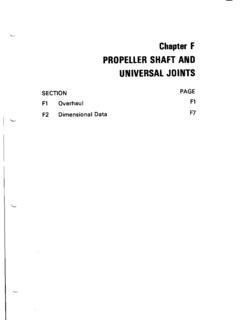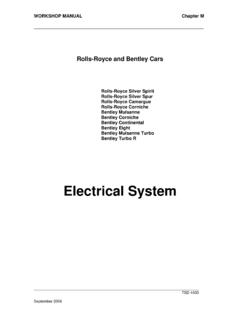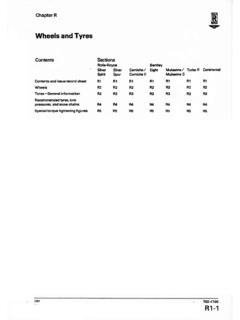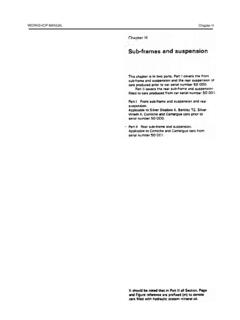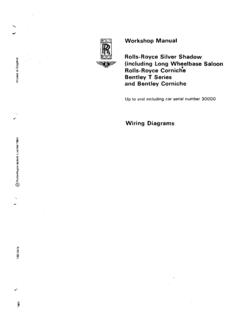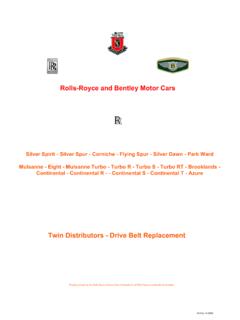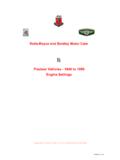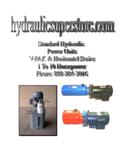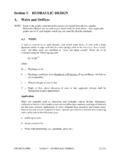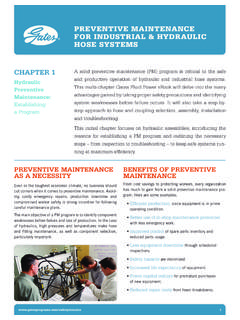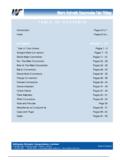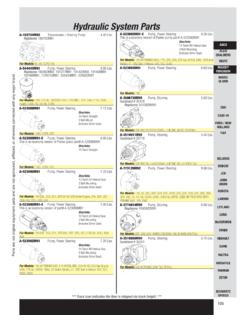Transcription of Chapter G - rrtechnical.info
1 Chapter G HYDRAULICS (POWER BRAKING AND AUTOMATIC HEIGHT CONTROL SYSTEMS) SECTION - Introduction Special Precautions Bleeding the hydraulic Systems hydraulic Systems Pipework hydraulic Systems Reservoirs hydraulic Pumps Hyd raulic Accumulators Height Control Valves Roll Restrictor Valve Solenoid Valve Height Control Rams Brake Master Cylinder Deceleration Conscious Pressure Limiting Valve Brake Distribution Valves Front and Rear Disc Brakes Brake Actuation Linkage Assembly Hand brake Linkage Fault Diagnosis PAGE G1 Rolls-Royce Silver Shadow & Bentley T Series Workshop Manual Chapter G HYDRAULICS (POWER BRAKING AND HEIGHT CONTROL SYSTEMS)
2 OC w 5 e 1 Introduction " The Rolls-Royce Silver Shadow and Bentley T Series motor cars are equipped with a power braking system and an automatic height control system, both of which utilise the same hydraulic fluid (refer to Chapter D), and employ similar power sources. The two systems are, to some extent, integrated and various components used in each system are common. Both systems are entirely new, thus different servicing procedures and operations are involved. Since some of these new procedures and techniques are common to both systems, the opportunity has INTRODUCTION been taken to combine the two in one Chapter under the general heading 'Hydraulics'.
3 Details of the mechanical hand brake linkage are included for convenience. Acknowledgement "Features of the hydraulic control of the brake system licenced by Soc. Anon. Andr6 Citroen under French Patent Number 1,014,251 and Pat. of Add. Number 61,598." Rolls- Royce Silver Shadow 8 Bentley T Series Workshop Manual Section GI SPECIAL PRECAUTIONS 3 Important It is of the utmost importance that Service Personnel should fully appreciate that the hydraulic systems " fitted to the Rolls-Royce Silver Shadow and Bentley T Series cars operate at high pressures. The systems are designed to operate safely under normal working conditions, but, as is the case with any high pressure fluid or gas, when service procedures are carried out or work is performed on the systems, certain precautions must be observed to ensure adequate safety to Personnel and equipment.
4 L It is essential that before attempting any work on the hydraulics of the car, Service Personnel should note carefully the contents of this Section and by fully conversant with the precautions which must be taken to ensure adequate safety and correct system operation. It is also important to note and conform with the instructions given on the reservoir sight glass plate and u, the hydraulic accumulator warning plates. s 6 Cleanliness For the correct functioning of the hydraulic systems it is imperative that meticulous care is taken to ensure complete cleanliness at all times. Since both the braking system and the height control system employ components which have very fine manufacturing limits, the ingress of even very fine particles of foreign matter could have very serious.
5 - effects on the operation of the systems. Care must therefore be taken to ensure that at all times only clean fluid of the specified type (refer to Chapter D) is used in the systems and that any over- hauled units or components have not been exposed to contamination before they are fitted to the car. Contact with mineral based oils must be avoided at all times as these oils have a detrimental effect on the rubber seals used in the hydraulic systems. hydraulic fluid Always refer to Chapter D for correct type of fluid to be used in the systems. It must be noted that brake fluid is hygroscopic, that the fluid will absorb and chemically combine with water from the atmosphere.
6 Brake fluid which is contaminated by water will boil at a much lower temperature than fluid with no water content. If the fluid is contaminated and the car is braked excessively or very hard from high speeds, there will be a tendency for the heat generated by the brakes to boil the fluid, finally resulting in vaporisation of the brake fluid and ineffective brakes. To eliminate possible contamination of the brake fluid it is most essential that the fluid is not exposed to the atmosphere for more than the absolute minimum of time. It should always be stored in and used direct from small sealed containers and when the systems are replenished, the two reservoir covers and the container cover must be replaced immediately.
7 Workshop Manual Rolls-Royce Silver Shadow B Bentley T Series Blanks Whenever units, pipes or components are dis- connected from the hydraulic systems dl open ports and pipe ends must be blanked off immediately to avoid system contamination. It is stressed. that the clean condition of any blanks used is equally as important as the clean condition of the components they seal. The size and type of each blank is as follows: Male 3 in. Female 4 in. Male & in. Female push-on blanking cap (two types). Male 13 in. Quantities of blanks may be obtained, on request, from the Parts Department at Crewe. Note Masking tape and/or cork bungs do not constitute blanks.
8 In addition, special pressure blanks are available, capable of withstanding full hydraulic system pres- sure, for use during testing and fault diagnosis procedures where it may be necessary to blank off a pipe or com- ponent and then charge the systems. The Part Numbers of the pressure blanks listed in the Tools Catalogue are as follows: When used, these blanks must be torque tightened to the figures quoted for the pipe unions which they replace. RH 7810 Male Q in. RH 7809 Female Q in. It must be noted that normal bleed screws may be used in place of charging adaptor plunger (RH 7810) if desired.
9 Precautions before working on the car Before any work, excepting bleeding and specified tests, is carried out on the car hydraulics, thesystems must be de-pressurised as follows: With the exception of bleed screws, pipes and com- ponents must never be disturbed when the systems are in a pressurised state. System De-pressurisation Either of the two following methods may be employed to de-pressurise the systems but generally it will be found that the first is the more convenient. Method 1 Switch on the ignition with the gearchange selector in Neutral or a car door open (fast height control conditions) but do not start the engine, then pump the brake pedal 50 or 60 times until both hydraulic warning lamps on the instrument panel are illuminated and remain illuminated.
10 De-pressurise the height control rams by placing a bleed tube on each ram bleed screw in turn, opening the screws and bleeding off the fluid into a clean container. After each ram has been de-pressurised the bleed screw must be tightened up and the reservoir topped- up to replace that fluid bled off. If the work on the system requires the removal of hydraulic pipes or components, disconnect the battery which is located in the boot. Method 2 With the ignition switched off, place a length of bleed tube over the bleed screw in the accumulator valve body and immerse and hold the free end in a clean container.

